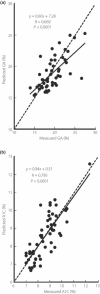Prediction of near-future glycated hemoglobin levels using glycated albumin levels before and after treatment for diabetes
- PMID: 24843503
- PMCID: PMC4014972
- DOI: 10.1111/j.2040-1124.2011.00107.x
Prediction of near-future glycated hemoglobin levels using glycated albumin levels before and after treatment for diabetes
Abstract
Aims/Introduction: In the present study, whether near-future glycated hemoglobin (A1C) levels could be predicted by changes in glycated albumin (GA) levels before and after treatment for diabetes was investigated.
Materials and methods: After starting diabetes treatment, GA and A1C levels are assumed to change exponentially. From this assumption, the equation for predicting near-future GA and A1C levels was derived. A total of 54 patients with type 2 diabetes mellitus in whom diabetes treatment was initiated or altered were enrolled. By incorporating GA and A1C values before and 2-4 weeks after starting treatment (second visit) into the equation, the predicted GA and A1C levels at the third visit (5-7 weeks after treatment) were obtained.
Results: A strong and positive correlation was observed between predicted GA and measured GA at the third visit (R = 0.669, P < 0.0001). Similarly, a strong and positive correlation was observed between the predicted A1C and the measured A1C at the third visit (R = 0.795, P < 0.0001).
Conclusions: GA and A1C levels 1-3 months after starting diabetes treatment could be predicted using the equation developed. The prediction of near-future A1C levels using GA levels at two points would be useful for judging the effectiveness of ongoing diabetes treatment at an earlier stage. (J Diabetes Invest, doi: 10.1111/j.2040-1124.2011.00107.x, 2011).
Keywords: Glycated albumin; Glycated hemoglobin; Glycemic control.
Figures


Similar articles
-
Correlation of glycated albumin but not hemoglobin A1c with endogenous insulin secretion in fulminant type 1 diabetes mellitus.J Diabetes Investig. 2010 Dec 3;1(6):279-82. doi: 10.1111/j.2040-1124.2010.00050.x. J Diabetes Investig. 2010. PMID: 24843444 Free PMC article.
-
The glycated albumin to glycated hemoglobin ratio might not be associated with carotid atherosclerosis in patients with type 1 diabetes.Diabetes Metab J. 2014 Dec;38(6):456-63. doi: 10.4093/dmj.2014.38.6.456. Epub 2014 Dec 15. Diabetes Metab J. 2014. PMID: 25541609 Free PMC article.
-
Introduction of glycated albumin measurement for all blood donors and the prevalence of a high glycated albumin level in Japan.J Diabetes Investig. 2012 Dec 20;3(6):492-7. doi: 10.1111/j.2040-1124.2012.00224.x. J Diabetes Investig. 2012. PMID: 24843613 Free PMC article.
-
Serum glycated albumin is superior to hemoglobin A1c for correlating with HMGB1 in coronary artery disease with type 2 diabetic mellitus patients.Int J Clin Exp Med. 2015 Apr 15;8(4):4821-5. eCollection 2015. Int J Clin Exp Med. 2015. PMID: 26131056 Free PMC article. Review.
-
Mistakes, misunderstandings and controversies in diabetes: A review and personal account.J Diabetes Investig. 2010 Jun 1;1(3):97-100. doi: 10.1111/j.2040-1124.2010.00012.x. J Diabetes Investig. 2010. PMID: 24843414 Free PMC article. Review.
Cited by
-
Estimation of HbA1c response to sitagliptin by change in glycated albumin level for 2 weeks.J Diabetes Investig. 2012 Mar 28;3(2):175-8. doi: 10.1111/j.2040-1124.2011.00167.x. J Diabetes Investig. 2012. PMID: 24843562 Free PMC article.
-
Alternative biomarkers for assessing glycemic control in diabetes: fructosamine, glycated albumin, and 1,5-anhydroglucitol.Ann Pediatr Endocrinol Metab. 2015 Jun;20(2):74-8. doi: 10.6065/apem.2015.20.2.74. Epub 2015 Jun 30. Ann Pediatr Endocrinol Metab. 2015. PMID: 26191510 Free PMC article. Review.
-
Estimation of Duration of Symptoms in Fulminant Type 1 Diabetes Mellitus Using HbA1c or Glycated Albumin.Jpn Clin Med. 2012 May 21;3:15-20. doi: 10.4137/JCM.S9509. eCollection 2012. Jpn Clin Med. 2012. PMID: 23946681 Free PMC article.
-
An Update on Measures of Preoperative Glycemic Control.Plast Reconstr Surg Glob Open. 2019 May 16;7(5):e2240. doi: 10.1097/GOX.0000000000002240. eCollection 2019 May. Plast Reconstr Surg Glob Open. 2019. PMID: 31333965 Free PMC article.
-
Aptamers: novel diagnostic and therapeutic tools for diabetes mellitus and metabolic diseases.J Mol Med (Berl). 2017 Mar;95(3):249-256. doi: 10.1007/s00109-016-1485-1. Epub 2016 Nov 15. J Mol Med (Berl). 2017. PMID: 27847965 Review.
References
-
- Cohen MP. Nonenzymatic glycation: a central mechanism in diabetic microvasculopathy? J Diabet Complications 1998; 2: 214–217 - PubMed
-
- Koenig RJ, Peterson CM, Jones RL, et al. Correlation of glucose regulation and hemoglobin AIc in diabetes mellitus. N Engl J Med 1976; 295: 417–420 - PubMed
-
- Bunn HF, Gabbay KH, Gallop PM. The glycosylation of hemoglobin: relevance to diabetes mellitus. Science 1978; 20: 21–27 - PubMed
-
- The Diabetes Control and Complications Trial Research Group . The effect of intensive treatment of diabetes on the development and progression of long‐term complications in insulin‐dependent diabetes mellitus. N Engl J Med 1993; 329: 977–986 - PubMed
-
- Nathan DM, Buse JB, Davidson MB, et al. Medical management of hyperglycemia in type 2 diabetes: a consensus algorithm for the initiation and adjustment of therapy: a consensus statement of the American Diabetes Association and the European Association for the Study of Diabetes. Diabetes Care 2009; 32: 193–203 - PMC - PubMed
LinkOut - more resources
Full Text Sources

